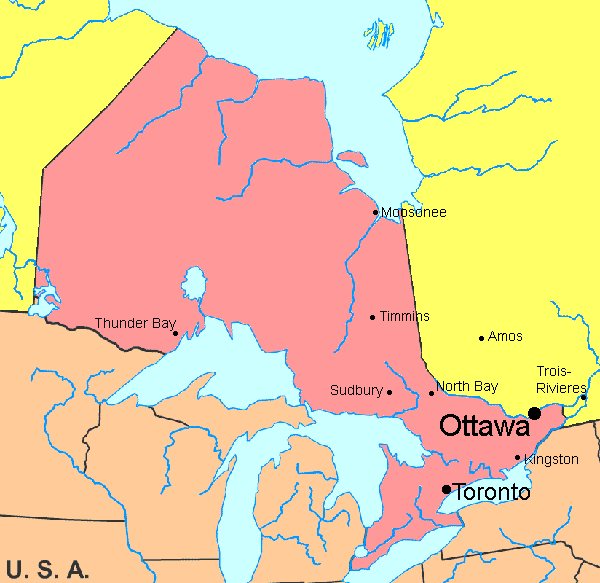|
Ontario
Ontario is the most populous of Canada's ten provinces. It is found in east-central Canada. Its capital is Toronto. Ottawa, the capital of Canada, is also located in Ontario. Ontario has a population (January 1, 2005) of 12,449,502, representing about 39% of the total Canadian population (Ontarians) and an area of 1,076,395km² (415,000 mi²) . The British established trading posts on Hudson Bay in the late 17th century and began a struggle for domination of Ontario. The 1763 Treaty of Paris ended the Seven Years War by awarding nearly all of France's North American possessions (New France) to Britain. The region was annexed to Quebec in 1774. From 1783 to 1796, the United Kingdom granted United Empire Loyalists leaving the United States following the American Revolution 200 acres (0.8 km²) of land and other items with which to rebuild their lives. This measure substantially increased the population of Canada west of the Ottawa River during this period, a fact recognized by the Constitutional Act of 1791, which split Quebec into The Canadas: Upper Canada west of the Ottawa River, and Lower Canada east of it. John Graves Simcoe was appointed Upper Canada's first Governor-General in 1793. American troops in the War of 1812 invaded Upper Canada across the Niagara River and the Detroit River but were successfully pushed back by British and Native American forces. The Americans gained control of Lake Erie and Lake Ontario, however, and during the Battle of York occupied the Town of York (later named Toronto) in 1813. After the War of 1812, many settlers from the British Isles immigrated to Upper Canada, and began to chafe against the aristocratic Family Compact that governed the region, much as the Château Clique ruled Lower Canada. Accordingly, rebellion in favour of responsible government rose in both regions; Louis-Joseph Papineau led the Patriotes Rebellion in Lower Canada, and William Lyon Mackenzie led the Upper Canada Rebellion. Although both rebellions were crushed, the British government sent Lord Durham to investigate the causes of the unrest. He recommended that self-government be granted and that Lower and Upper Canada be re-joined in an attempt to assimilate the Québécois. Accordingly, the two colonies were merged into the Province of Canada by the Act of Union (1840), with Ontario becoming known as Canada West. Parliamentary self-government was granted in 1848. By about 1850, the English-speaking population of Canada West surpassed the French-speaking population of Canada East. A political stalemate between the French- and English-speaking legislators, as well as fear of aggression from the United States during the American Civil War, led the political elite to hold a series of conferences in the 1860s to effect a broader federal union of all British North American colonies. The British North America Act took effect on July 1, 1867, establishing the Dominion of Canada, initially with four provinces: Nova Scotia, New Brunswick, Quebec and Ontario. The Province of Canada was divided at this point into Ontario and Quebec so that each linguistic group would have its own province. Both Quebec and Ontario were required by section 93 of the BNA Act to safeguard existing educational rights and privileges of the Protestant and Catholic minorities. Neither province had a constitutional requirement to protect its French- or English-speaking minority. Toronto was formally established as Ontario's provincial capital at this time. Mineral exploitation began in the late 19th century, leading to the rise of important mining centres like Sudbury, Cobalt and Timmins. The province harnessed its water power to generate hydro-electric power, and created the state-controlled Hydro-Electric Power Commission of Ontario, later Ontario Hydro. The availability of cheap electric power further facilitated the development of industry. In 1904 the Canadian automobile industry was launched in what is now Windsor, Ontario with the establishment of the Ford Motor Company of Canada. General Motors of Canada Ltd. was formed in 1918. The motor vehicle industry would become the major industrial component of the Ontario economy. Influenced by events in the United States, the government of Sir William Hearst introduced prohibition of alcoholic drinks in 1916 with the passing of the Ontario Temperance Act. Prohibition came to an end in 1927 with the establishment of the Liquor Control Board of Ontario by the government of George Howard Ferguson. The sale of liquor and beer is still tightly-controlled by the state to ensure that the maximum revenues go to the provincial treasury. The post-World War II period was one of exceptional prosperity and growth. Ontario, and the Greater Toronto Area in particular, have been the recipients of most immigration to Canada. Changes in federal immigration law have led to a massive influx of non-Europeans since the 1980s. From a largely ethnically British province, Ontario has now become very culturally diverse. |
||||||||||
